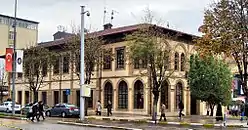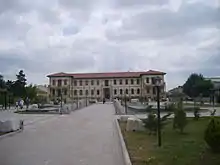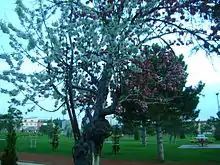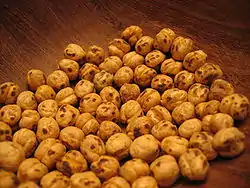Çorum
Çorum (Turkish pronunciation: [ˈtʃoɾum]; Medieval Greek: Ευχάνεια, romanized: Euchaneia) is a northern Anatolian city that is the capital of the Çorum Province of Turkey. Çorum is located inland in the central Black Sea Region of Turkey, and is approximately 244 km (152 mi) from Ankara and 608 km (378 mi) from Istanbul. The city has an elevation of 801 m (2,628 ft) above sea level, a surface area of 12,820 km2 (4,950 sq mi), and as of the 2016 census, a population of 237,000.[3]
Çorum | |
|---|---|
 Çorum Municipality Building, City Square | |
 Çorum  Çorum | |
| Coordinates: 40°33′00″N 34°57′14″E | |
| Country | Turkey |
| Province | Çorum |
| Government | |
| • Mayor | Halil Ibrahim Asgin (AKP) |
| Area | |
| • District | 2,276.81 km2 (879.08 sq mi) |
| Population (2012)[2] | |
| • Urban | 231,146 |
| • District | 265,242 |
| • District density | 120/km2 (300/sq mi) |
| Website | www.corum.bel.tr |
Çorum is primarily known for its Phrygian and Hittite archaeological sites, its thermal springs, and its native roasted chick-pea snacks known nationally as leblebi.
History
The history of the area around the present-day city is known to go as far back as the Paleolithic ages, with small settlements and tools from the era variously having been excavated over the past century.[4]
The town also seems to have been an Assyrian trading post acting as a connection between Anatolia and Mesopotamia between 1950 and 1850 BC.
The city and surrounding area rose to prominence with the emergence of the Hittite Empire between 1650-1200 BC, under the patronage of which the arts and local economy significantly developed and prospered. Hattusa, the capital of Hittite Empire, was located in the region owing to its inherent geographic protection, and the well-established local economy as supported by the regional Karum system.[4]
Following the collapse of the Hittites, the Phrygian Empire continued to keep stability in the region.
After the Phrygians, the city underwent various rulerships, with the most prominent being the Medes, the Persians, Macedonians, Galatians, the Romans, the Byzantines, the Seljuks, and ultimately the Ottomans in the fourteenth century.[4]
In the early twentieth century, during the Turkish War of Independence, Çorum was among the cities with the highest count of Turkish casualties, with 1510 Medals of Independence being awarded to troops from the city[4] and its surrounding villages.
The city officially joined the Republic of Turkey following the declaration of the Republic in 1923. In 1980, radical Sunni Muslims perpetrated the Çorum Massacre against the Alevis, killing 57 and injuring more than 200.
The etymology of the city's name is uncertain.
Çorum today




The town today is generally tidy and pleasant, with a locally popular countryside. As with most Central Anatolian and inland Black Sea towns, the population is largely conservative, leading to a generally more restricted nightlife that favors dry establishments, although there are some bars, pubs and cafés that offer a mix of contemporary and traditional Turkish folk music. Within the city, there is a good range of shops, cafés and restaurants, with a cuisine that includes a variety of pastries including the nationally-known Çorum Mantısı - a popular dish similar to ravioli that is slowly baked in a brick oven or steamed in a beef broth. As well as the archeological and other historic sites, the countryside surrounding Çorum offers many places for picnics, particularly near the Çomar reservoir or in the mountains around the province.
The old Ottoman houses, the 19th century clock tower, and the Çorum Museum that displays a range of artefacts from excavations in the region are popular tourist interests. An International Hittite Congress of archaeologists is held in Çorum every three years.
Economy
Although the economic output of the city has historically been relatively small with a focus on traditional crafts like coppersmithing, tanning, hand weaving, agriculture and animal husbandry, over the past two decades, the city has shown a significant growth in industrial production and light engineering that has made it among the most industrially advanced cities compared to its population size.
Originally home to about 20 tile and brick manufactories and 10 flour and feed mills, the city today produces a wide variety of products ranging from cement to automobile parts, refined sugar to dairy products, textiles to computer parts, and more recently, poultry through chicken farming.[5]
Population
| Population of the city of Çorum | ||
|---|---|---|
| 2017 | 527,863 | |
| 2009 | 206,600 | |
| 2000 | 161,321 | |
| 1990 | 116,810 | |
| 1985 | 96,725 | |
| 1980 | 75,726 | |
| 1970 | 57,576 | |
Geography
Çorum is on the northern edge of the Central Anatolian Plateau. There is an attractive mountainous countryside around the city. The North Anatolian Fault line passes 20 km (12 mi) south of Çorum.
Climate
Çorum has a warm dry-summer continental climate (Köppen climate classification: Dsb) with dry summers and cold, snowy winters, and mild to cool wet springs and autumns with light rain.
| Climate data for Çorum | |||||||||||||
|---|---|---|---|---|---|---|---|---|---|---|---|---|---|
| Month | Jan | Feb | Mar | Apr | May | Jun | Jul | Aug | Sep | Oct | Nov | Dec | Year |
| Average high °C (°F) | 4.2 (39.6) |
6.2 (43.2) |
11.6 (52.9) |
17.4 (63.3) |
22.0 (71.6) |
25.9 (78.6) |
29.0 (84.2) |
29.3 (84.7) |
25.6 (78.1) |
19.7 (67.5) |
12.6 (54.7) |
6.4 (43.5) |
17.5 (63.5) |
| Daily mean °C (°F) | −0.4 (31.3) |
0.9 (33.6) |
5.1 (41.2) |
10.5 (50.9) |
14.8 (58.6) |
18.5 (65.3) |
21.1 (70.0) |
21.0 (69.8) |
17.0 (62.6) |
11.8 (53.2) |
5.9 (42.6) |
1.9 (35.4) |
10.7 (51.2) |
| Average low °C (°F) | −4.3 (24.3) |
−3.7 (25.3) |
−0.6 (30.9) |
3.8 (38.8) |
7.3 (45.1) |
10.2 (50.4) |
12.4 (54.3) |
12.3 (54.1) |
9.0 (48.2) |
5.2 (41.4) |
0.7 (33.3) |
−1.9 (28.6) |
4.2 (39.6) |
| Average precipitation mm (inches) | 38.4 (1.51) |
30.4 (1.20) |
37.8 (1.49) |
52.6 (2.07) |
60.2 (2.37) |
54.3 (2.14) |
20.3 (0.80) |
14.4 (0.57) |
22.7 (0.89) |
29.9 (1.18) |
36.6 (1.44) |
47.2 (1.86) |
444.8 (17.52) |
| Average rainy days | 11.7 | 10.7 | 11.7 | 12.9 | 13.9 | 10.3 | 4.3 | 3.2 | 4.7 | 7.8 | 9.0 | 11.8 | 112 |
| Mean monthly sunshine hours | 77.5 | 98 | 151.9 | 186 | 238.7 | 273 | 316.2 | 313.1 | 252 | 176.7 | 111 | 65.1 | 2,259.2 |
| Source: Devlet Meteoroloji İşleri Genel Müdürlüğü [6] | |||||||||||||
Notable natives
- Mahmut Atalay - World champion and Olympic medalist wrestler
- Tevfik Kış - World champion and Olympic medalist wrestler
- Cevdet Cerit - professor of mathematics at Istanbul Technical University
- Komet or Gürkan Coşkun - Famous Turkish artist
- Soner Yalçın - Famous Turkish journalist, arrested for Ergenekon trials
- İbrahim Kaypakkaya - Founder of Türkiye Komünist Partisi/Marksist-Leninist
- İsmail Beşikçi - Writer
- Aşık Gülabi (Gülabi Gültekin) - Minstrel
- Gen. Ahmet Çörekçi - Former Head Commander of the Turkish Air Force
- Ahmet Atlamaz - Famous Turkish intelligence agent
- Savaş Yurderi Kool Savas - a German rapper and hip hop artist
See also
References
- "Area of regions (including lakes), km²". Regional Statistics Database. Turkish Statistical Institute. 2002. Retrieved 2013-03-05.
- "Population of province/district centers and towns/villages by districts - 2012". Address Based Population Registration System (ABPRS) Database. Turkish Statistical Institute. Retrieved 2013-02-27.
- Statistical Institute
- History of Çorum Archived 2009-03-17 at the Wayback Machine
- Economy of Çorum Archived 2009-03-17 at the Wayback Machine
- "Archived copy". Archived from the original on 2011-04-30. Retrieved 2011-03-18.CS1 maint: archived copy as title (link)
External links
| Wikivoyage has a travel guide for Çorum. |
- Provincial governor's web site
- Pictures of the city with links to surrounding Hittite sites
- Chisholm, Hugh, ed. (1911). . Encyclopædia Britannica. 6 (11th ed.). Cambridge University Press. p. 270.


